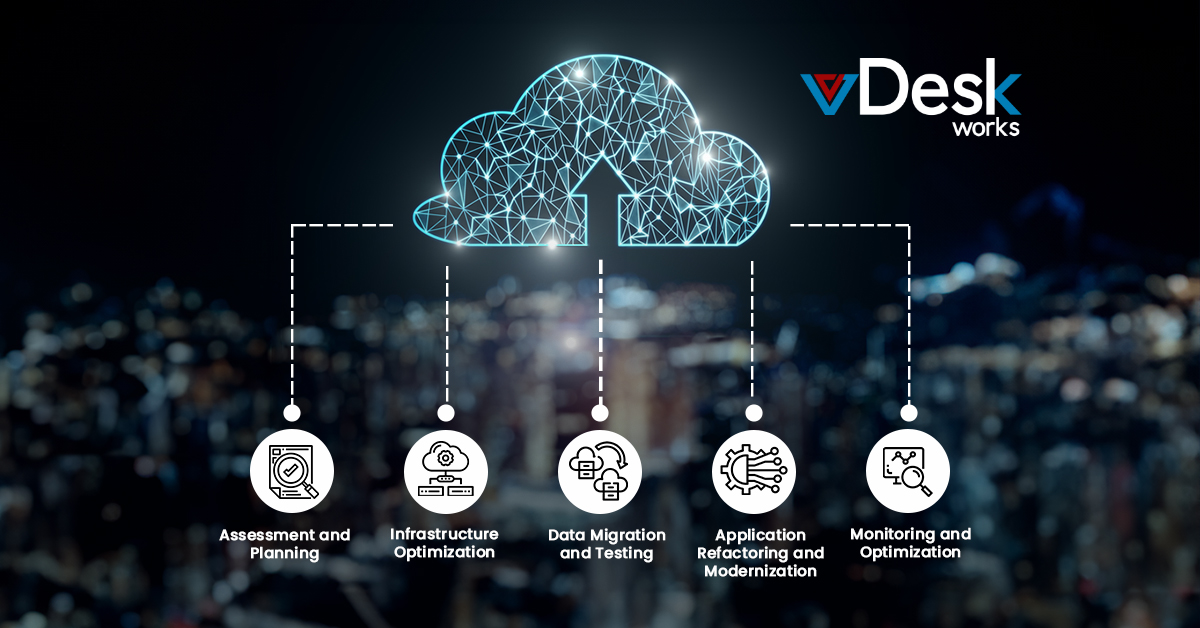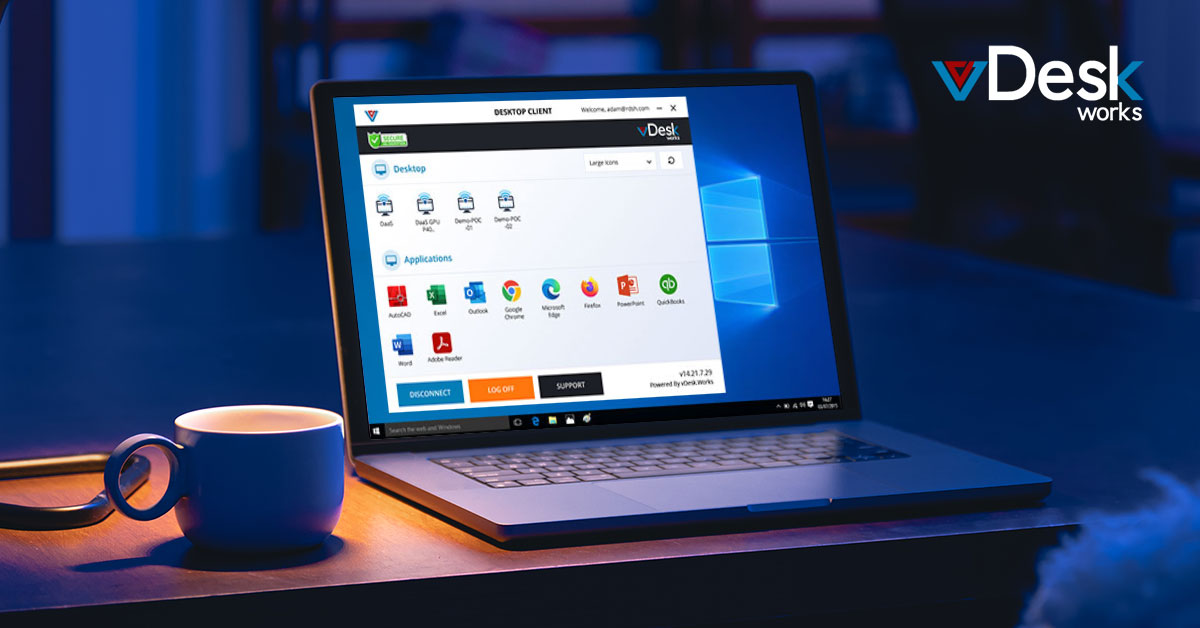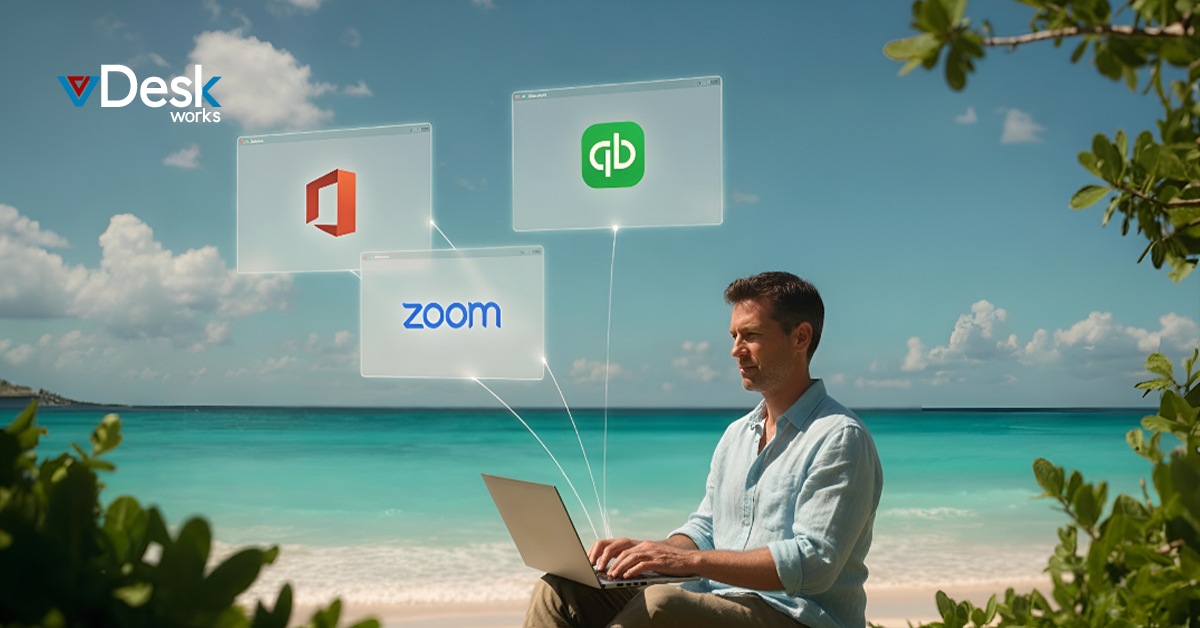In the current digital time, businesses are increasingly realizing the advantages of moving their on-premise structure to the Cloud. As cloud technology grows and there is a rising need for flexibility and expandability at low cost, shifting to the Cloud becomes an important strategy for organizations wanting to remain competitive in 2024 or later. Here, we will discuss the steps required to achieve flawless on-premise to cloud migration and why businesses must contemplate moving their data from on-premise into the Cloud. Furthermore, we will discuss the decision between one Cloud or many clouds and how vDesk.works' Cloud Desktop Solution can make shifting to the Cloud easier.
Why Migrate Data from On-Premise to the Cloud?
Cost Savings
Moving to the Cloud can save businesses a lot on their IT infrastructure costs. This involves buying and keeping hardware up-to-date and using less power to run these systems.
Flexibility and Quickness
With cloud computing, businesses can rapidly implement new services and apps, adjust to market fluctuations, and react more efficiently to customer needs.
Advanced Security
Cloud providers dedicate significant resources to ensuring Security for both data and infrastructure. They offer high-level security characteristics, encryption options, and compliance certifications that protect your sensitive information.
Collaboration and Accessibility
Cloud-based solutions encourage easy teamwork between far-off teams by allowing access to data and applications from any place at any time. This boosts effectiveness in work.
In view of these persuasive advantages, businesses are increasingly adopting cloud migration as a tactical move to update their IT systems and stimulate digital transformation.
Single Cloud or Multi-Cloud Approach
For a cloud migration strategy, companies must choose between having one or using multiple clouds. Every option has its advantages and disadvantages. The decision about which way is better depends on factors like workload requirements, budget limitations, and worries related to being tied too closely to just one vendor.
Single Cloud Approach
Selecting one cloud supplier can bring simplicity and uniformity and perhaps decrease expenses because of bulk reductions. Nevertheless, it might restrict adaptability and increase the possibility of vendor lock-in.
Multi-Cloud Approach
By using a multi-cloud method, businesses can take advantage of the best features from various cloud providers. This helps reduce the possibility of downtime or service problems and prevents them from getting trapped with only one vendor. Yet, handling more than one cloud environment might be difficult and require extra resources and skills.
In the end, the company's choice to use a single-cloud or multi-cloud method must match its goals, significance, and IT approach.
5 Steps for a Successful Cloud Migration from On-Premises Infrastructure
Assessment and Planning
Note down the main business reasons, migration goals, and dependencies to create a thorough plan for moving. Take into account elements like data safety, following rules or standards, and how well it performs to help with making decisions.
Infrastructure Optimization
Prior to moving to the Cloud, optimize your current infrastructure. This means simplifying things, decreasing expenses, and enhancing performance. You can do this by combining servers, dismantling old systems, and adjusting network setups so that the migration becomes more efficient and cost-effective.
Data Migration and Testing
When the migration plan is ready, start the process of moving data from physical servers to the Cloudthe . Do this using trustworthy tools and methods that guarantee consistency, correctness, and as little service interruption as possible. Test thoroughly the workloads that have been moved over to make sure they perform well, function correctly, and are compatible with cloud environments.
Application Refactoring and Modernization
Alongside the data migration process, evaluate and reorganize current applications for better performance in terms of costs, scalability, and suitability with cloud environments. Make old applications more modern by using cloud-native architectures, putting them into containers, and creating microservices. This helps to use cloud computing fully and encourages innovation.
Monitoring and Optimization:
- Once you finish moving to the Cloud, monitor it constantly. This includes checking that it works at its best in terms of speed, safety, and cost control.
- Use monitoring tools and analytics to check how much each resource is used, find possible problems, and make improvements to improve efficiency and reduce costs in your cloud resources area.
- Review your cloud settings, rules, and access rights often so they match changing business requirements and good safety maintenance methods.
Leveraging vDesk.works' Cloud Desktop Solution for Seamless Migration

For businesses starting their journey of moving to the Cloud, using vDesk.works' Cloud Desktop Solution can make the migration process more efficient and help them get full benefits from cloud computing. The company provides a wide range of desktop in the Cloud solutions intended to improve productivity, simplify operation, and guarantee smooth remote entry into applications and information.
With vDesk.works' Cloud Desktop Solution, businesses can:
Easy Deployment
With vDesk.works' Cloud Desktop Solution, you can handle all virtual desktops, applications, and user access from a single centralized platform. This makes it simple for businesses to deploy and expand their resources.
Enhance Security
vDesk.works show great concern for Security. They have strong safety measures in place, like encryption, access controls, and protection for data and infrastructure. This guarantees that your system is safe and follows all industry rules.
Optimize Performance
The Cloud Desktop Solution from vDesk works to optimize its performance through the usage of advanced technologies and infrastructure. These provide high-speed and dependable desktop experiences accessible from all locations and devices.
Achieve High Flexibility
vDesk.works allow for flexible deployment choices - public, private, and hybrid cloud solutions. This permits businesses to customize their cloud setting according to the requirements and adjust as needs change.
Drive Collaboration
vDesk.works' Cloud Desktop Solution enhances the collaboration of remote teams by giving them easy entry to applications and data, allowing real-time communication and teamwork for better productivity across scattered teams.
With the Cloud Desktop Solution of vDesk.works, businesses can hasten their journey into the Cloud, lessen complicatedness, and tap into the complete power of cloud computing to foster innovation and growth in 2024 onwards.
In summary, reaching the ideal transition from on-premise to cloud calls for well-thought-out planning, implementation, and utilization of suitable tools and technologies. Adhering to the five stages highlighted in this blog post and using vDesk.works' Cloud Desktop Solution, companies can expertly handle the intricacies of cloud migration. This method allows them to fully utilize cloud computing, leading digital transformation in 2024 and further ahead.


 Emma Carson
Emma Carson
















